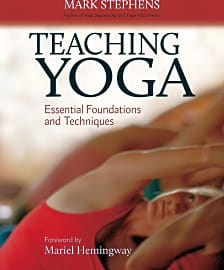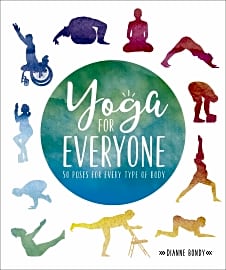The 10 Best Yoga Books

This wiki has been updated 38 times since it was first published in September of 2015. Whether you use it for meditative purposes, general fitness, or to build strength, yoga can be a healthy addition to any daily regimen. Our selection of books on the topic will help you improve your knowledge and technique, understand the science behind the art, and are written for a variety of audiences, from first-timers to those aiming to try their hand as instructors. When users buy our independently chosen editorial selections, we may earn commissions to help fund the Wiki.
Editor's Notes
April 16, 2020:
We curated this list with a wide range of yogis in mind, from the aspiring teacher and unsure beginner to the science-minded practitioner. We wanted to strike a balance between useful, practical instruction and clarification, uplifting spiritual guidance, and facts-based research so that our selection has something for everyone.
Today's update saw the addition of Yoga for Everyone and Science of Yoga. The first is an extremely accessible text that shows the myriad ways a pose can be altered to suit individual needs, whether you are big, small, young, old, pregnant, or disabled. It uses models with a variety of backgrounds and physical attributes to clearly showcase how 50 popular poses can be attained. In addition to that, it has information regarding breathing techniques and what equipment like yoga blocks and flexibility straps are for. It explains each pose very well, but be aware that it doesn't get into extreme detail on every aspect of each one.
Science of Yoga is for all the practitioners out there who want tangible proof on how the art can help physically and mentally. It breaks down, in great detail, how yoga benefits the body using up to date research. Things people have been claiming for years — that it helps with arthritis, prevents age-related brain changes, reduces inflammation, lowers blood pressure, etc — are backed up with clearly presented facts. The Key Muscles of Yoga and Yoga Anatomy are also excellent picks if you want to know more about the physical side of things.
We also brought The Complete Guide to Yin Yoga up to date by adding the recently revised edition of the text. It now includes a more functional approach to the practice by emphasizing the concept of targeted areas and the importance of stress in reducing fragility, as well as a revised list of effective counter postures and many new photographs, to name a few enhancements.
Special Honors
ClassPass If you've picked up a yoga book and are interested in trying out what you've learned at a studio, you might want to look into ClassPass. ClassPass Inc. is a company that provides access to different fitness classes such as yoga, strength training, barre, martial arts, pilates, boxing, indoor cycling, and more via a flat-rate monthly subscription service. You sign up, choose your activity, and book through the app, which also makes recommendations for you. classpass.com
Glo App Designed to help users feel better physically and mentally, Glo is an app that provides unlimited access to over 4,000 online yoga, meditation, and pilates classes led by world-class teachers. The sleek design is easy to navigate and suggests classes for you to try based on a questionnaire you fill out. You can also use their filters to make selections based on your fitness level, desired duration, the body part you're targeting, and more. glo.com
A Brief History Of Yoga
Yoga may have been practiced as much as 3,500 years ago, as it seems to be mentioned in the sacred Hindu text known as the Rigveda which dates to approximately 1400 BCE.
If you and your friends enthusiastically frequent the newest "Hot Yoga" studio, then indeed you are practicing a form of yoga that is itself rather new. Hot yoga, a common term for what is more specifically known as Bikram Yoga, is a practice created in the 1970s by world famous yogi Bikram Choudry.
The practice consists of a series of 26 yoga postures (or positions) and breathing exercises all conducted in a space heated to approximately 104 degrees Fahrenheit. The high temperatures associated with Hot Yoga are intended to facilitate greater flexibility, increased calorie burning, and, with long term commitment to the practice, reduced body fat and increased strength.
Many experts warn that some of the benefits associated with Hot Yoga may be limited at best, and that the practice can lead to dehydration and hyperthermia, both of which are dangerous conditions to be avoided whenever possible. Few people, however, question the many benefits of practicing traditional yoga, which is more traditionally known as Hatha Yoga, a practice that dates back thousands of years. Yoga may have been practiced as much as 3,500 years ago, as it seems to be mentioned in the sacred Hindu text known as the Rigveda which dates to approximately 1400 BCE.
The practice of yoga can be definitely linked to various practitioners alive during the 5th and 6th Centuries BCE, with mentions and illustrations of yoga located across much of present day India. Yoga remained largely an Indian (and Hindu) pursuit for much of the Common Era, with its practice only making inroads in Western society around the turn of the last century. Throughout the 20th Century yoga slowly grew in popularity in America, and in the last few decades of that century it caught on globally, both as a part of a fitness regimen and as a spiritual practice.
The word itself, yoga, is interpreted in many ways. It can be taken to mean everything from "to unite" or "exertion" or "combined." Regardless of the etymological specificities, which are blurred by time and by individual interpretation anyway, yoga is more popular today than at any point during its millennia of history. Those interested in practicing yoga or in studying its influences and its influence have at their disposal a wealth of source material, with more yoga books joining the panoply each and every year.
Yoga As Part Of A Fitness Routine
If you are interested in learning about and participating in yoga as part of a fitness regimen, then your study should involve both the positions and practices associated with yoga as well as a study of human anatomy. By blending a scientific approach to understanding the physiology of the body and the movements and exertions you will experience in yoga, you can craft a holistic approach to exercise.
The more a fitness enthusiast reads about yoga, the better he or she can fit its practice into a wider exercise routine.
Yoga can help build long, lean muscles, and it can do wonders for flexibility. It cannot greatly increase your strength or build developed (e.g. "cut") muscles associated with lifting, however, and yoga can only do so much in terms of cardiovascular fitness development. (For the record, weightlifting will do little to improve flexibility, and might even limit it.)
A savvy athlete will use the practice of yoga to help maintain a flexible body and to strengthen his or her core. They will also use traditional strength training exercises, such as weight lifting, resistance training, and/or calisthenics, to develop specific muscle groups. Other cardiovascular training routines should also be a requisite for the dedicated fitness enthusiast, as yoga simply can't help someone achieve the same consistently elevated heart rate that jogging, cycling, rowing, or other activities provide.
The more a fitness enthusiast reads about yoga, the better he or she can fit its practice into a wider exercise routine. And keep in mind that while many people associate yoga with its spiritual aspects, there is no need to approach the practice as anything more than a physical activity if you so wish it. The benefits of limberness and flexibility are without question, even if you question your need for added mind-body and emotional connection.
Practicing Yoga For Mental And Spiritual Balance
Beyond the physical aspects of yoga -- the balance it requires and helps to develop, the core strength it refines, and the flexibility its long term practice leads too -- there is a potent emotional and spiritual side to the committed practice of yoga. If you're not sure yoga will suit you, or if you are struggling to make a deeper connection to this ancient discipline after your first forays, reading the right yoga book might be a great way to foster one.
Even practicing yoga without mastery can have its benefits, as it forces the mind to reorient itself to a new set of challenges and goals.
Some people treat yoga as a meditative experience, losing themselves in the practice and even melding aspects of Zen Buddhism (or other religious prayers or practices) with their yoga routine. Regardless of the depths to which you choose to associate yoga with emotional or spiritual introspection, the mere act of taking time to work on a discipline that inherently requires patience and devotion can have a markedly beneficial improvement on one's life.
Practicing and mastering yoga can help someone who may feel as though they are floundering in one aspect of their life find a renewed sense of balance and control. Even practicing yoga without mastery can have its benefits, as it forces the mind to reorient itself to a new set of challenges and goals.















